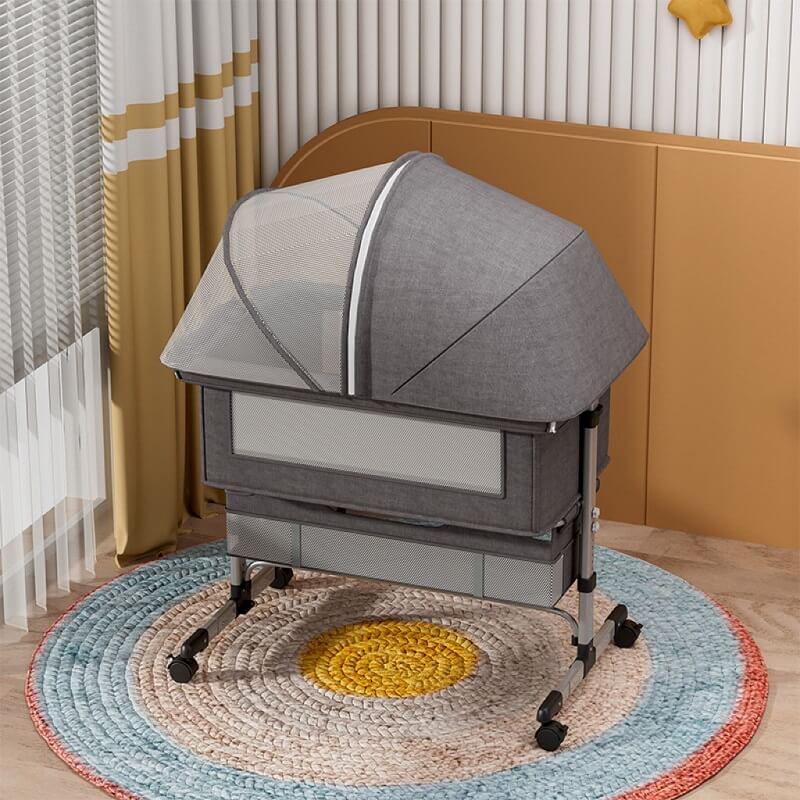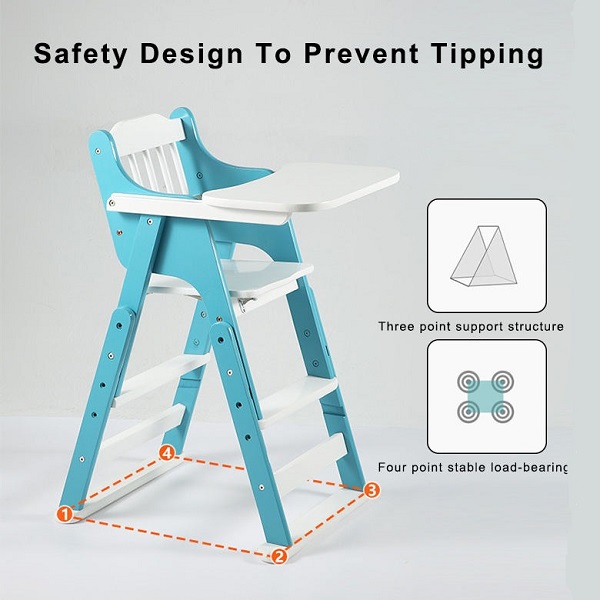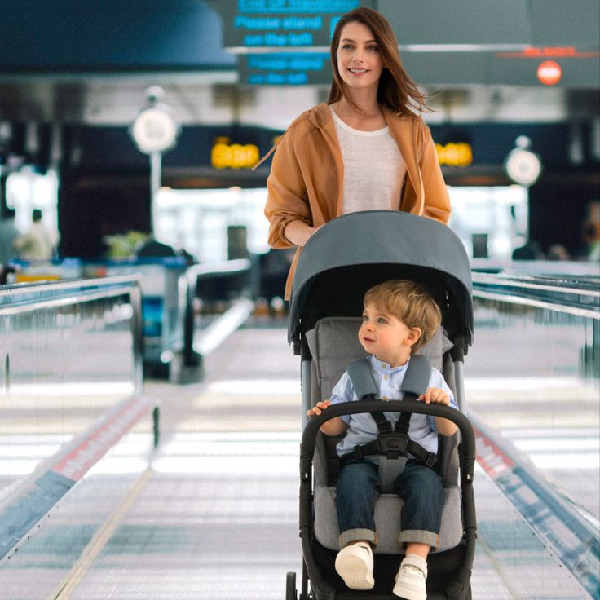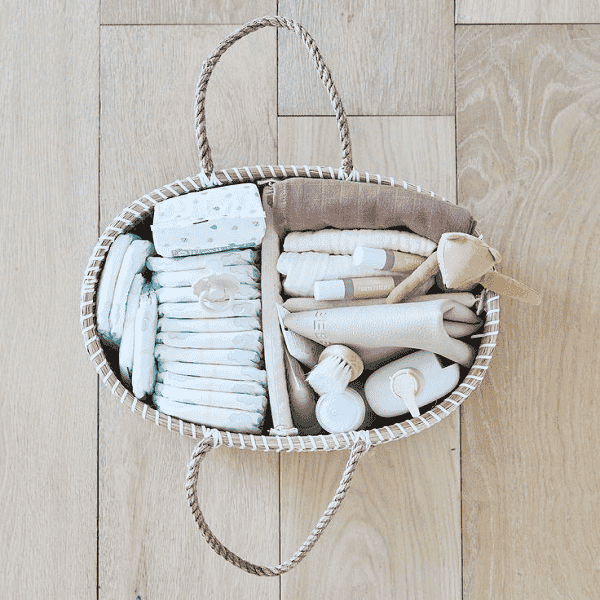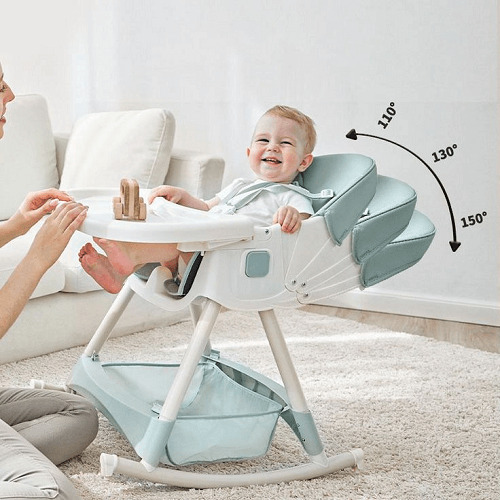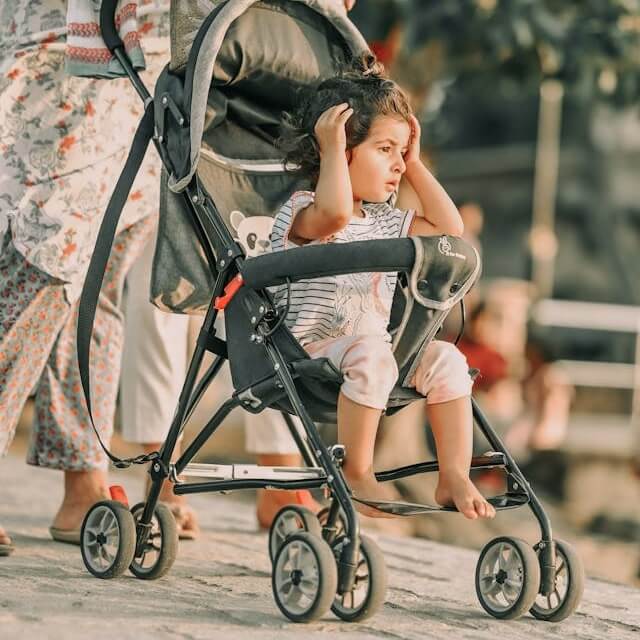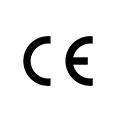Importance of a baby bassinet
As a new parent, one of the most important things you can do for your little one is to ensure they have a safe and comfortable place to sleep. That’s where a baby bassinet comes in. A baby bassinet is a small, cozy bed that is designed specifically for newborns and infants. It provides a secure and comforting environment for your baby to sleep, while also offering convenience for parents.
There are several reasons why a baby bassinet is important. First and foremost, it promotes safe sleep practices. The American Academy of Pediatrics recommends that infants sleep in the same room as their parents for the first six months, and a bassinet allows you to do just that. It provides a separate sleeping area for your baby, while still keeping them within arm’s reach. This proximity can help reduce the risk of Sudden Infant Death Syndrome (SIDS) and allows you to easily monitor and comfort your baby throughout the night.
Additionally, a baby bassinet offers portability. Unlike a crib, which is bulky and not easily moved, a bassinet is lightweight and often comes with wheels or handles for easy transportation. This means that you can keep your baby close by during the day, whether you’re in the living room, kitchen, or even outside in the yard. It’s a convenient way to ensure your baby is always within sight and reach, no matter where you are in your home.
Lastly, a baby bassinet provides a cozy and snug sleeping space for your little one. Newborns are used to the confined space of the womb, and a bassinet simulates that feeling of security. The small size and soft bedding of a bassinet create a comforting environment that can help soothe your baby and promote better sleep. This is especially important during the early months when your baby is adjusting to life outside the womb and needs all the comfort and reassurance they can get.
Different types of baby bassinets
When it comes to choosing a baby bassinet, there are several different types to consider. Each type has its own unique features and advantages, so it’s important to understand your options before making a decision.
- Traditional bassinets: These are the classic, standalone bassinets that are designed to be placed next to your bed. They usually have a sturdy frame with a fabric or mesh enclosure and a mattress for your baby to sleep on. Traditional bassinets are great for keeping your baby close by at night while still maintaining a separate sleeping space.
- Co-sleeper bassinets: Co-sleeper bassinets are designed to attach securely to the side of your bed, allowing your baby to sleep right alongside you. They often have a drop-down side or a removable panel for easy access to your baby during the night. Co-sleeper bassinets are ideal for parents who want to have their baby within arm’s reach for nighttime feedings and soothing.
- Convertible bassinets: Convertible bassinets are a versatile option that can be used as both a bassinet and a play yard. They often have a removable bassinet attachment that can be used for newborns and infants, and then converted into a play yard as your baby grows. Convertible bassinets are a cost-effective choice that can grow with your child.
- Travel bassinets: If you’re frequently on the go, a travel bassinet may be the right choice for you. These bassinets are lightweight, compact, and easy to fold up, making them perfect for travel and overnight stays. They often come with a carrying bag for easy transportation and storage.
Now that you have an understanding of the different types of baby bassinets available, let’s move on to the next section, where we’ll discuss the factors to consider when choosing a baby bassinet.
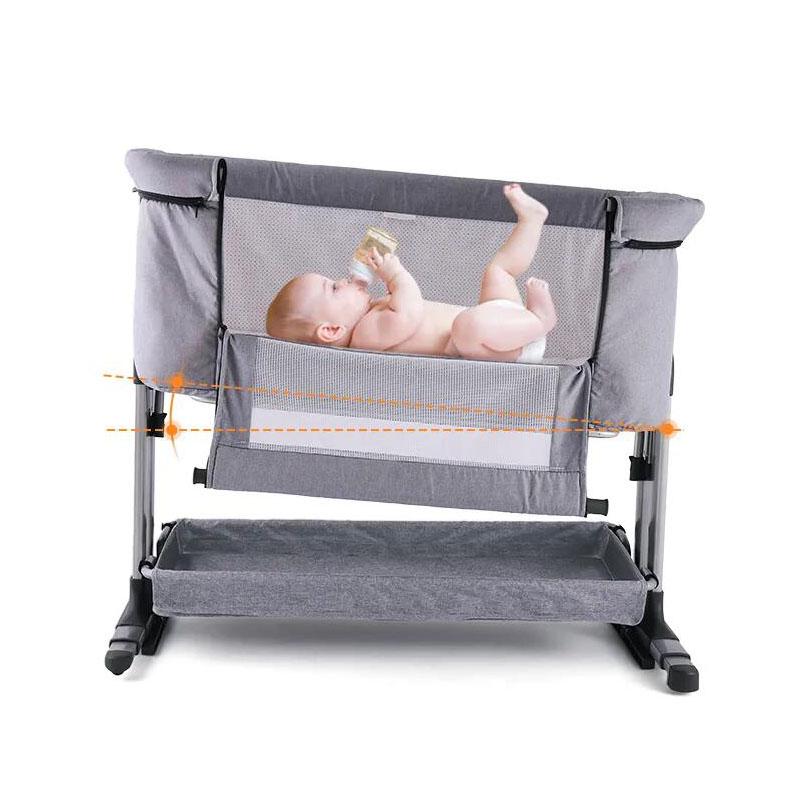
Factors to consider when choosing a baby bassinet
Choosing the perfect baby bassinet for your little one can seem like a daunting task with so many options available. However, by considering a few key factors, you can narrow down your choices and find the best bassinet for your needs. Here are some important factors to consider when making your decision:
- Safety: Safety should always be your top priority when choosing a baby bassinet. Look for bassinets that meet the safety standards set by organizations such as the Juvenile Products Manufacturers Association (JPMA) and the Consumer Product Safety Commission (CPSC). Make sure the bassinet has a sturdy frame, breathable sides, and a firm mattress that fits snugly. Avoid bassinets with loose bedding, pillows, or stuffed animals, as they can pose a suffocation hazard.
- Size and weight: Consider the size and weight of the bassinet, especially if you have limited space in your home or if you plan on traveling frequently. Measure the area where you plan to place the bassinet to ensure it will fit comfortably. If you’re looking for a travel bassinet, choose one that is lightweight and easy to transport.
- Portability: If you want to keep your baby close by during the day or if you plan on traveling, portability is an important factor to consider. Look for bassinets that are easy to move, either because they have wheels or because they are lightweight and foldable. Some bassinets even come with a carrying bag for added convenience.
- Adjustability: Babies grow and change quickly, so it’s helpful to choose a bassinet that offers some level of adjustability. Look for bassinets with adjustable mattress heights, as well as ones that can convert into a play yard or crib. This way, you can continue to use the bassinet as your baby grows, saving you money in the long run.
- Ease of use and maintenance: Consider how easy the bassinet is to set up, use, and clean. Look for features such as a removable mattress cover or a washable mattress pad for easy cleaning. Make sure the bassinet has clear assembly instructions and that it is easy to access your baby, whether it’s through a drop-down side or a removable panel.
By taking these factors into account, you can choose a baby bassinet that meets your needs and provides a safe and comfortable sleeping environment for your little one.
Safety guidelines for baby bassinets
When it comes to your baby’s safety, it’s important to follow some guidelines when using a bassinet. Here are some key safety tips to keep in mind:
- Always place the bassinet on a flat and stable surface: Ensure that the bassinet is placed on a firm and level surface to prevent it from tipping over. Avoid placing the bassinet on high surfaces such as countertops or tables, as your baby can fall and get injured.
- Keep the bassinet away from hazards: Make sure the bassinet is placed away from curtains, blinds, cords, and other potential hazards that your baby could reach. This will help prevent accidents such as entanglement or strangulation.
- Avoid using soft bedding or pillows: It’s important to create a safe sleep environment for your baby. Avoid using soft bedding, pillows, or stuffed animals in the bassinet, as they can pose a suffocation risk. Instead, use a fitted sheet and a firm mattress that fits snugly.
- Check for recalls: Before purchasing a baby bassinet, make sure to check for any recalls or safety issues. You can do this by visiting the manufacturer’s website or checking the Consumer Product Safety Commission’s website.
- Monitor your baby while they sleep: Even though a bassinet allows you to keep your baby close by, it’s important to still monitor them while they sleep. Regularly check on your baby to ensure they are in a safe position and that nothing is obstructing their breathing.
By following these safety guidelines, you can create a safe and secure sleeping environment for your little one.
Top features to look for in a baby bassinet
When choosing a baby bassinet, there are several features that you should look for to ensure the best possible sleep experience for your little one. Here are some top features to consider:
- Sturdy construction: Look for a bassinet with a sturdy and durable construction. The frame should be solid and stable, and the bassinet should not wobble or sway when touched. This will ensure the safety and stability of the bassinet.
- Breathable sides: Opt for a bassinet with breathable mesh sides. This allows for proper air circulation and helps prevent overheating, which is important for your baby’s comfort and safety during sleep.
- Adjustable mattress height: Choose a bassinet that offers adjustable mattress heights. This allows you to easily reach your baby when they are small, and then lower the mattress as they grow and become more mobile. It also helps with reducing the risk of your baby climbing out of the bassinet.
- Easy access: Look for a bassinet with easy access to your baby. This can be in the form of a drop-down side, a removable panel, or a bassinet that swivels. Easy access makes it convenient for nighttime feedings and diaper changes.
- Portability: If you plan on moving the bassinet from room to room or if you’ll be traveling with it, portability is an important feature to consider. Look for bassinets with wheels or ones that are lightweight and foldable for easy transportation.
- Soothing features: Some bassinets come with built-in soothing features such as vibrations, music, or nightlights. These can help calm and comfort your baby, making it easier for them to fall asleep and stay asleep.
- Storage space: Consider a bassinet that offers storage space for essentials such as diapers, wipes, and extra bedding. This can help keep everything you need for your baby’s sleep within reach and organized.
By looking for these features in a baby bassinet, you can choose a product that meets your needs and provides a comfortable and convenient sleep solution for your little one.
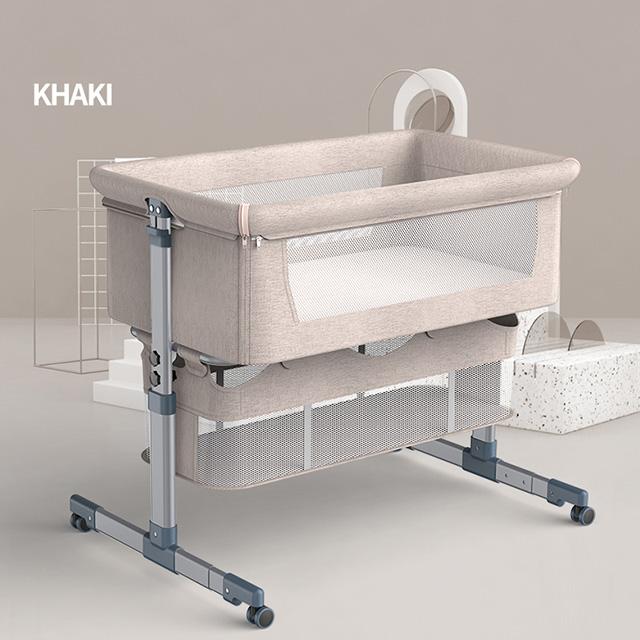
Best baby bassinets for newborns
When it comes to choosing the best baby bassinet for newborns, there are several options that stand out. Here are some top recommendations:
- Halo Bassinest Swivel Sleeper: This bassinet is loved by many parents for its unique swivel design, which allows you to easily bring your baby close to you and then swivel them away when needed. It has breathable mesh sides, an adjustable height, and a soothing center with a nightlight, music, and vibration.
- Fisher-Price Soothing Motions Bassinet: This bassinet features a soothing center with gentle vibrations, calming music, and nature sounds. It has a sturdy frame, breathable mesh sides, and a flat sleeping surface. It also comes with a storage basket for convenience.
- Graco Dream Suite Bassinet: This bassinet offers a two-in-one design, with a removable bassinet that can be used as a standalone sleeper. It has breathable mesh sides, a canopy to shield your baby from light, and a reversible mattress for a firm or quilted sleep surface.
- BabyBjorn Cradle: This sleek and modern bassinet has a gentle rocking motion that helps soothe your baby to sleep. It has breathable mesh sides, a lightweight design for easy portability, and a machine-washable mattress cover.
- Arm’s Reach Concepts Cambria Co-Sleeper Bassinet: This co-sleeper bassinet attaches securely to your bed, allowing your baby to sleep right alongside you. It has breathable mesh sides, an adjustable height, and a storage basket for essentials.
These are just a few examples of the best baby bassinets for newborns. When choosing a bassinet, consider your specific needs and preferences, as well as the safety and comfort features that are important to you and your baby.
Best baby bassinets for small spaces
If you have limited space in your home, don’t worry – there are baby bassinets that are designed specifically for small spaces. Here are some top recommendations:
- Chicco LullaGo Portable Bassinet: This bassinet has a compact and lightweight design, making it perfect for small spaces. It has breathable mesh sides, a sturdy frame, and a comfortable mattress. It also folds up easily for storage or travel.
- Mika Micky Bedside Sleeper: This bedside sleeper is designed to attach securely to your bed, allowing your baby to sleep right alongside you without taking up extra space. It has a drop-down side for easy access to your baby and a storage pocket for essentials.
- Delta Children Sweet Beginnings Bassinet: This bassinet has a small footprint, making it ideal for small spaces. It has a sturdy frame, breathable mesh sides, and a comfortable mattress. It also comes with a canopy to shield your baby from light.
- Summer Infant Bentwood Bassinet with Motion: This bassinet has a compact and modern design that fits well in small spaces. It has a gentle rocking motion, a breathable mesh side, and a removable canopy. It also comes with a storage basket for convenience.
When choosing a bassinet for small spaces, look for ones with a compact footprint, lightweight design, and easy storage options. These features will help you maximize the limited space you have while still providing a safe and comfortable sleeping environment for your baby.
Best baby bassinets for travel
If you’re a frequent traveler or if you’ll be taking overnight trips with your baby, a travel bassinet is a must-have. Here are some top recommendations for the best baby bassinets for travel:
- Lotus Travel Crib and Portable Baby Playard: This travel bassinet is lightweight, compact, and easy to set up. It has breathable mesh sides, a comfortable mattress, and a zippered side door for easy access to your baby. It also comes with a backpack carrying case for convenience.
- BABYBJORN Travel Crib Light: This travel bassinet is designed for easy transportation and setup. It has a lightweight construction, a soft and comfortable mattress, and mesh sides for breathability. It also comes with a carrying case for portability.
- Graco Pack ‘n Play On The Go Playard: The On-the-Go Bassinet is a portable and easy-to-use option for travel. It has a quick and hassle-free setup, allowing you to assemble it in seconds. The bassinet also has a sturdy and stable frame, ensuring a safe sleeping space for your baby. It is lightweight and comes with a carrying case, making it perfect for on-the-go parents.
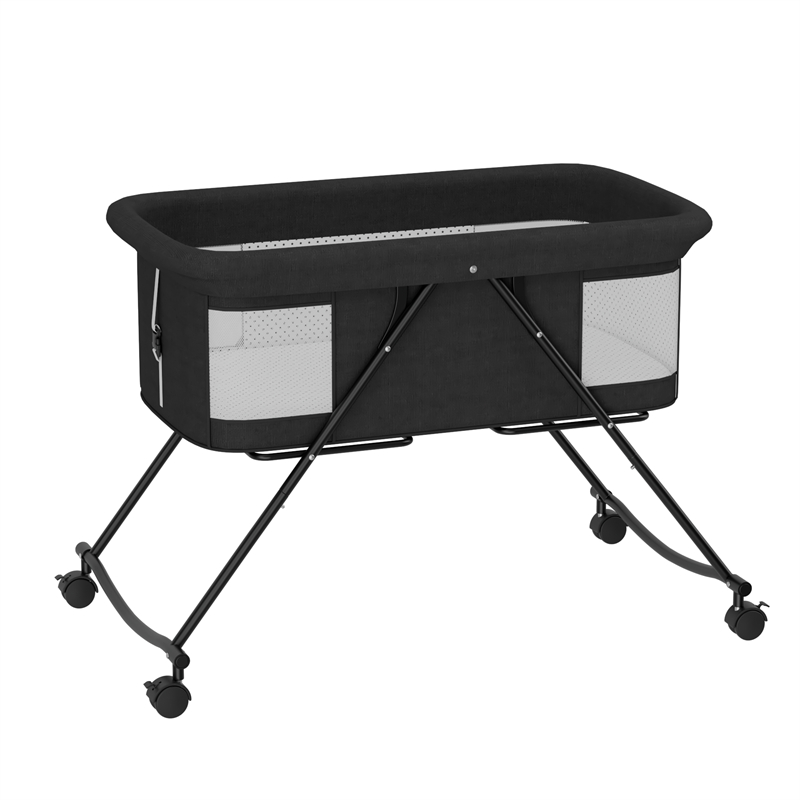
How to Set Up and Use a Baby Bassinet
Setting up and using a baby bassinet may seem daunting at first, but with a few simple steps, you can ensure a safe and comfortable sleeping environment for your little one.
- Choose the Right Location: Before setting up your baby bassinet, choose a safe and convenient location. Make sure the bassinet is placed away from cords, curtains, and other potential hazards. It should also be away from heaters, air conditioners, and direct sunlight.
- Follow the Assembly Instructions: Each baby bassinet comes with specific assembly instructions. Read through the instructions carefully and follow each step to ensure proper setup. Pay attention to details such as tightening screws and securing all parts.
- Prepare the Mattress and Bedding: Once the bassinet is assembled, prepare the mattress and bedding. Use a firm and snug-fitting mattress that meets safety standards. Avoid using loose or fluffy bedding, as it can pose a suffocation risk. Use a fitted sheet that is specifically designed for the bassinet.
- Keep the Bassinet Clean: Regularly clean the bassinet to ensure a hygienic sleeping environment for your baby. Follow the manufacturer’s instructions for cleaning and maintenance. Wipe down the bassinet with a mild detergent and warm water. Avoid using harsh chemicals or abrasive cleaners.
- Monitor Your Baby: Always keep an eye on your baby while they are in the bassinet. Check on them regularly to ensure they are safe and comfortable. Avoid placing any additional items in the bassinet, such as toys or pillows, as they can pose a suffocation risk.
Baby Bassinet Care and Maintenance Tips
Taking care of your baby bassinet is essential to ensure its longevity and safety. Here are some tips for caring for and maintaining your baby bassinet.
- Regularly Clean and Inspect: Clean the bassinet regularly to keep it free from dirt, dust, and allergens. Inspect the bassinet for any signs of wear and tear, such as loose screws or broken parts. Replace any damaged or worn-out components immediately.
- Follow Manufacturer’s Instructions: Always follow the manufacturer’s instructions for cleaning and maintenance. They will provide specific guidelines on how to properly care for your baby bassinet. Avoid using harsh chemicals or abrasive cleaners that can damage the materials.
- Store Properly When Not in Use: If you are not using the bassinet for an extended period, make sure to store it properly. Disassemble the bassinet if possible and pack it in a secure and dry location. Keep it away from extreme temperatures and direct sunlight.
- Check for Recalls: Stay updated with any recalls or safety notices regarding your baby bassinet. Manufacturers may issue recalls if there are any safety concerns or defects. Check the manufacturer’s website or subscribe to their notifications to stay informed.
- Follow Safety Guidelines: Always adhere to the safety guidelines provided by the manufacturer. This includes weight limits, recommended usage age, and proper positioning of the bassinet. Avoid using the bassinet once your baby has outgrown the recommended weight or age limit.
Conclusion
Choosing the perfect sleep solution for your little one is a crucial decision that requires careful consideration. Whether you are looking for a bassinet for newborns, small spaces, or travel, there are plenty of options available to suit your needs. Remember to prioritize safety, comfort, and convenience when making your choice.
By following the proper setup and usage guidelines, as well as caring for and maintaining your baby bassinet, you can provide a safe and cozy sleeping environment for your little one. Always stay updated with any recalls or safety notices and follow the manufacturer’s instructions for optimal use.
With the right baby bassinet, you can ensure that your little one gets the quality sleep they need for healthy growth and development. So, take your time, do your research, and make an informed decision that will give both you and your baby peace of mind.


